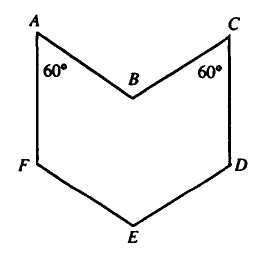Difference between revisions of "1983 AHSME Problems/Problem 4"
(→Solution) |
Sevenoptimus (talk | contribs) (Fixed problem statement) |
||
| Line 1: | Line 1: | ||
== Problem 4 == | == Problem 4 == | ||
| − | + | [[File:pdfresizer.com-pdf-convert.png]] | |
| − | and sides <math>BC</math> and <math>ED</math>. Each side has length | + | |
| + | In the adjoining plane figure, sides <math>AF</math> and <math>CD</math> are parallel, as are sides <math>AB</math> and <math>EF</math>, | ||
| + | and sides <math>BC</math> and <math>ED</math>. Each side has length <math>1</math>. Also, <math>\angle FAB = \angle BCD = 60^\circ</math>. | ||
The area of the figure is | The area of the figure is | ||
<math> | <math> | ||
| − | \ | + | \textbf{(A)} \ \frac{\sqrt 3}{2} \qquad |
| − | \ | + | \textbf{(B)} \ 1 \qquad |
| − | \ | + | \textbf{(C)} \ \frac{3}{2} \qquad |
| − | \ | + | \textbf{(D)}\ \sqrt{3}\qquad |
| − | \ | + | \textbf{(E)}\ 2</math> |
[[1983 AHSME Problems/Problem 4|Solution]] | [[1983 AHSME Problems/Problem 4|Solution]] | ||
Revision as of 17:15, 26 January 2019
Problem 4
In the adjoining plane figure, sides ![]() and
and ![]() are parallel, as are sides
are parallel, as are sides ![]() and
and ![]() ,
and sides
,
and sides ![]() and
and ![]() . Each side has length
. Each side has length ![]() . Also,
. Also, ![]() .
The area of the figure is
.
The area of the figure is
![]()
Solution
![[asy] pair A, B, C, D, E, F; A = (0, 1.732); B = (0.5, 0.866); C = (0,0); D = (1, 0); E = (1.5, 0.866); F = (1, 1.732); draw(A--B--C--D--E--F--A); label("$A$", A, NW); label("$B$", B, 3W); label("$C$", C, SW); label("$D$", D, SE); label("$E$", E, E); label("$F$", F, NE); draw(B--D, dashed+linewidth(0.5)); draw(B--E, dashed+linewidth(0.5)); draw(B--F, dashed+linewidth(0.5)); [/asy]](http://latex.artofproblemsolving.com/b/d/d/bddb9e658c2a3f38841b9348a1aa73ffaeadbc5e.png)
Drawing the diagram as described, we create a convex hexagon with all side lengths equal to 1. In this case, it is a natural approach to divide the figure up into four equilateral triangles. The area, A, of one such equilateral triangle is ![]() , which gives a total of
, which gives a total of  , or
, or ![]() .
.
See Also
| 1983 AHSME (Problems • Answer Key • Resources) | ||
| Preceded by Problem 3 |
Followed by Problem 5 | |
| 1 • 2 • 3 • 4 • 5 • 6 • 7 • 8 • 9 • 10 • 11 • 12 • 13 • 14 • 15 • 16 • 17 • 18 • 19 • 20 • 21 • 22 • 23 • 24 • 25 • 26 • 27 • 28 • 29 • 30 | ||
| All AHSME Problems and Solutions | ||
The problems on this page are copyrighted by the Mathematical Association of America's American Mathematics Competitions. 










